Structural Characteristics of the Yangtze-Huaihe Cold Shear Line over Eastern China in Summer
Abstract
1. Introduction
2. Data and Methods
2.1. Data
2.2. Methods
2.2.1. Objective Identification of the YCSL
2.2.2. Composite Analysis of the YCSL
3. Evolution Process of the YCSL
4. Circulation Characteristics of the YCSL
4.1. Circulation Characteristics at 850 hPa
4.2. Circulation Characteristics at 500 hPa and 200 hPa
5. Evolution Characteristics of the YCSL’s Dynamic Structure
5.1. Horizontal Direction
5.2. Vertical Direction
6. Evolution Characteristics of the YCSL’s Thermal Structure
6.1. Thermal Structure
6.1.1. Horizontal Direction
6.1.2. Vertical Direction
6.2. Water Vapor Characteristics
7. Causes of the YCSL’s Northward-Inclined Structure
8. Conclusion and Discussion
Author Contributions
Funding
Acknowledgments
Conflicts of Interest
References
- Gao, S.T.; Zhou, Y.S.; Lei, T. Structural features of the Meiyu front system. Acta Meteorol. Sin. 2002, 16, 195–204. [Google Scholar]
- Sun, J.H.; Zhang, F.Q. Impacts of mountain–plains solenoid on diurnal variations of rainfalls along the Meiyu front over the East China Plains. Mon. Weather Rev. 2012, 140, 379–397. [Google Scholar] [CrossRef]
- Yang, S.; Gao, S.T.; Lu, C.G. A generalized frontogenesis function and its application. Adv. Atmos. Sci. 2014, 31, 1065–1078. [Google Scholar] [CrossRef]
- Luo, X.; Xue, M.; Fei, J.F. Simulation and Analysis of the Initiation of a Squall Line within a Meiyu Frontal System in East China. Atmosphere 2018, 9, 183. [Google Scholar] [CrossRef]
- Wu, C.H.; Huang, W.R.; Wang, S.Y. Role of Indochina Peninsula Topography in Precipitation Seasonality over East Asia. Atmosphere 2018, 9, 255. [Google Scholar] [CrossRef]
- Saito, N. Quasi-stationary waves in mid-latitudes and Baiu in Japan. J. Meteorol. Soc. Jpn. 1985, 63, 983–995. [Google Scholar] [CrossRef]
- Ninomiya, K.; Muraki, H. Large- scale circulation over East Asia during Baiu period of 1979. J. Meteorol. Soc. Jpn. 1986, 64, 409–429. [Google Scholar] [CrossRef]
- Okada, Y.; Yamazaki, K. Climatological evolution of the Okinawa Baiu and differences in large-scale features during May and June. J. Clim. 2012, 25, 6287–6303. [Google Scholar] [CrossRef]
- Oh, J.H.; Kwon, W.T.; Ryoo, S.B. Review of the researches on Changma and future observational Study(KORMEX). Adv. Atmos. Sci. 1997, 14, 207–222. [Google Scholar] [CrossRef]
- Riyu, L.; Oh, J.H.; Kim, B.J.; Baek, H.J. Associations with the interannual variations of onset and withdrawal of the Changma. Adv. Atmos. Sci. 2001, 18, 1066–1080. [Google Scholar] [CrossRef]
- Tao, S.Y. The relation between Mei-Yu in Far East and the behaviour of circulation over Asia. Acta Meteorol. Sin. 1958, 29, 119–134. [Google Scholar]
- Ye, D.Z.; Tao, S.Y.; Li, M.C. The abrupt change of circulation over Northern Hemisphere during June and October. Acta Meteorol. Sin. 1958, 29, 249–263. [Google Scholar]
- Tao, S.Y.; Chen, L.X. A review of recent research on the East Asian summer monsoon in China. In Monsoon Meteorology; Chang, C.P., Krishnamurti, T.N., Eds.; Oxford University Press: New York, NY, USA, 1987; pp. 60–92. [Google Scholar]
- Ding, Y.H. Summer monsoon rainfalls in China. J. Meteorol. Soc. Jpn. 1992, 70, 373–396. [Google Scholar] [CrossRef]
- Ding, Y.H. Seasonal March of the East Asian Summer Monsoon. In East Asian Monsoon; Chang, C.P., Ed.; World Scientific: Singapore, 2004; pp. 3–53. [Google Scholar]
- Wu, C.H.; Chou, M.D.; Fong, Y.H. Impact of the Himalayas on the Meiyu-Baiu migration. Clim. Dyn. 2017, 50, 1307–1319. [Google Scholar] [CrossRef]
- Ding, Y.H.; Chan, C.L. The East Asian summer monsoon: An overview. Meteorol. Atmos. Phys. 2005, 89, 117–142. [Google Scholar] [CrossRef]
- Chen, T.J. Research on the phenomena of Meiyu during the past quarter century: An overview. East Asian Monsoon; Chang, C.P., Ed.; World Scientific: Singapore, 2004; p. 564. [Google Scholar]
- Zheng, Y.G.; Chen, J.; Ge, G.Q.; Huang, Y.F.; Zhang, C.X. Review on the synoptic scale Meiyu Front system and its synopticsdefinition. Acta Sci. Nat. Univ. Pekin. 2008, 44, 157–164. [Google Scholar] [CrossRef]
- LinHo; Wang, B. The time–space structure of the Asian-Pacific summer monsoon: A fast annual cycle view. J. Clim. 2002, 15, 2001–2019. [Google Scholar]
- Shin, C.-S.; Huang, B. Slow and fast annual cycles of the Asian Summer Monsoon in the NCEP CFSv2. Clim. Dyn. 2016, 47, 529–553. [Google Scholar] [CrossRef]
- Lee, J.-Y.; Kwon, M.; Yun, K.-S.; Min, S.-K.; Park, I.-H.; Ham, Y.-G.; Jin, E.K.; Kim, J.H.; Seo, K.-H.; Kim, W.; et al. The long-term variability of Changma in the East Asian summer monsoon system: A review and revisit. Asia-Pac. J. Atmos. Sci. 2017, 53, 257–272. [Google Scholar] [CrossRef]
- Luo, X.; Fei, J.; Huang, X.; Ding, J.; Ma, Z. Relative roles of dry intrusion, latent heat and instabilities in the Mei-yu rainband life cycle: A case study. Atmos. Res. 2018, 214, 10–20. [Google Scholar] [CrossRef]
- Sampe, T.; Xie, S.-P. Large-scale dynamics of the Meiyu-Baiu rainband: Environmental forcing by the westerly jet. J. Clim. 2010, 23, 113–134. [Google Scholar] [CrossRef]
- Wu, R.; Wang, B. Multi-stage onset of the summer monsoon over the western North Pacific. Clim. Dyn. 2001, 17, 277–289. [Google Scholar] [CrossRef]
- Wang, B.; Lin, H. Rainy season of the Asian-Pacific summer monsoon. J. Clim. 2002, 15, 386–396. [Google Scholar] [CrossRef]
- Wang, Y.F.; Gao, Q.L.; Rong, Y.S. Decadal climate variability of rainfall around the middle and lower reaches of the Yangte River and atmospheric circulation. J. Trop. Meteorol. 2005, 11, 169–177. [Google Scholar]
- Si, D.; Ding, Y.H.; Liu, Y.J. Decadal northward shift of the Meiyu belt and the possible cause. Chin. Sci. Bull. 2009, 54, 4742–4748. [Google Scholar] [CrossRef]
- Zhu, Y.L.; Wang, H.J.; Zhou, W.; Ma, J.H. Recent changes in the summer precipitation pattern in East China and the background circulation. Clim. Dyn. 2011, 36, 1463–1473. [Google Scholar] [CrossRef]
- Ding, Y.H.; Si, D.; Liu, Y.J.; Fan, K. On the characteristics, driving forces and inter-decadal variability of the East Asian summer monsoon. Chin. J. Atmos. Sci. 2018, 42, 533–558. [Google Scholar]
- Shou, S.W.; Li, S.S.; Zhang, C.Z.; Fan, K. The dynamical structure of a mesoscale shear-line rain belt on Meiyu front. Acta Meteorol. Sin. 2001, 59, 405–413. [Google Scholar]
- Wu, R.S. The Principle of Modern Weather; Advanced Education Press: Beijing, China, 1999; p. 319. [Google Scholar]
- Yao, X.P.; Sun, J.Y.; Ma, J.L. Advances on research of Yangtze-Huaihe shear line. Plateau Meteorol. 2017, 36, 1138–1151. (In Chinese) [Google Scholar] [CrossRef]
- Wen, S.G. The synoptic background and trigger mechanism of shear line heavy rain. Meteorl. Mon. 1999, 25, 44–48. [Google Scholar] [CrossRef]
- Sun, J.H.; Zhang, X.L.; Qi, L.L.; Zhang, G.Y.; Zhao, S.X.; Tao, S.Y. A study of vortex and its mesoscale convective system during China heavy rainfall experiment and study in 2002. J. Atmos. Sci. 2004, 28, 675–691. (In Chinese) [Google Scholar]
- Zhao, S.X.; Tao, Z.Y.; Sun, J.H.; Bei, N.F. Study on Mechanism of Formation and Development of Heavy Rainfalls on Meiyu Front in Yangtze River; Meteorological Press: Beijing, China, 2004; p. 69. [Google Scholar]
- Zhang, J.; Wang, Y.; Xu, L.R. Synoptic analysis and numerical simulation of heavy rainstorm process caused by a Meiyu Front. Plateau Meteorol. 2012, 31, 170–1710. [Google Scholar]
- Ma, J.L. Climatic Stastistical Ananlysis and Composite Analysis of Shear Line Over Yangtze-Huaihe River Region during Meiyu Period; M.S., Chinese Academy of Meteorological Sciences: Beijing, China, 2016. [Google Scholar]
- Ma, J.; Yao, X.P. Statistical analysis of the shear lines and torrential rains over the Yangtze-Huaihe river region during June–July in 1981–2013. Acta Meteorol. Sin. 2015, 73, 883–894. [Google Scholar] [CrossRef]
- Zhou, Y.H.; Huang, X.Y.; Li, Z.X.; Wu, X.Y.; Xia, Z.L. Analysis of doppler radar echo feature of heavy rain events at the edge of west Pacific subtropical high. Meteorl. Mon. 2006, 32, 12–17. [Google Scholar] [CrossRef]
- Zhang, J.Y.; Zhu, S.L.; Wang, H.Q.; Wu, J.; Pei, H.Q. A radar comparison analysis of two rainstorms for cold and worm shear-line. Sci. Meteorol. Sin. 2007, 27, 44–51. [Google Scholar] [CrossRef]
- Ding, Y.H.; Wang, X.F. An analysis of the distribution of apparent heat sources and sinks over the middle reaches of the Yangtze River during the Meiyu season in 1983. J. Trop. Meteorol. 1988, 4, 134–145. [Google Scholar]
- Wang, C.M.; Wu, R.S.; Wang, Y. Interaction of diabatic frontogenesis and moisture processes in cold-frontal rain-band. Adv. Atmos. Sci. 2002, 19, 554–561. [Google Scholar] [CrossRef]
- Dee, D.P.; Uppala, S.M.; Simmons, A.J.; Berrisford, P.; Poli, P.; Kobayashi, S.; Andrae, U.; Balmaseda, M.A.; Balsamo, G.; Bauer, P. The ERA-Interim reanalysis: Configuration and performance of the data assimilation system. Q. J. R. Meteorol. Soc. 2011, 137, 553–597. [Google Scholar] [CrossRef]
- Chen, Q.S. The Instability of the Gravity-inertia wave and its Relation to Low-level Jet and Heavy Rainfall. J. Meteorol. Soc. Jpn. 1982, 60, 1041–1057. [Google Scholar] [CrossRef]
- Shin, C.-S.; Lee, T.Y. Development mechanism for the heavy rainfalls of 6–7 August 2002 over the middle of the Korean peninsula. J. Meteorol. Soc. Jpn. 2005, 83, 683–709. [Google Scholar] [CrossRef][Green Version]
- Zhang, H.H.; Yao, X.P.; Gao, Y.; Guan, Q.; Wang, G.C. Preliminary analysis on the causes of the first persistent heavy rainfall in Yangtze-Huaihe river valley in 2016. J. Trop. Meteorol. 2018, 34, 674–684. [Google Scholar] [CrossRef]
- Zhang, R.P.; Ma, X.L.; Sheng, W.B.; Xu, R.G. Characteristics of the main influential system of Jianghuai Meiyu Storm in June 2011. Trans. Atmos. Sci. 2014, 37, 366–377. [Google Scholar] [CrossRef]
- Li, X.R.; Zhang, X.R.; Pu, M.J. Composite analysis of the evolving of Yangtze River and Huaihe River shear line with heavy rain and without heavy rain in Meiyu period. Plateau Meteorol. 2014, 33, 199–209. [Google Scholar]
- Liu, J.J.; Ding, Y.H.; He, J.H. The structure analysis of a typical Meiyu Front. Acta Meteorol. Sin. 2003, 61, 291–302. [Google Scholar] [CrossRef]
- Zheg, Y.G.; Chen, J.; Ge, G.Q.; Zhu, P.J. Typical structure diversity and multi-scale characteristics of Meiyu Front. Acta Meteorol. Sin. 2007, 65, 760–772. [Google Scholar] [CrossRef]
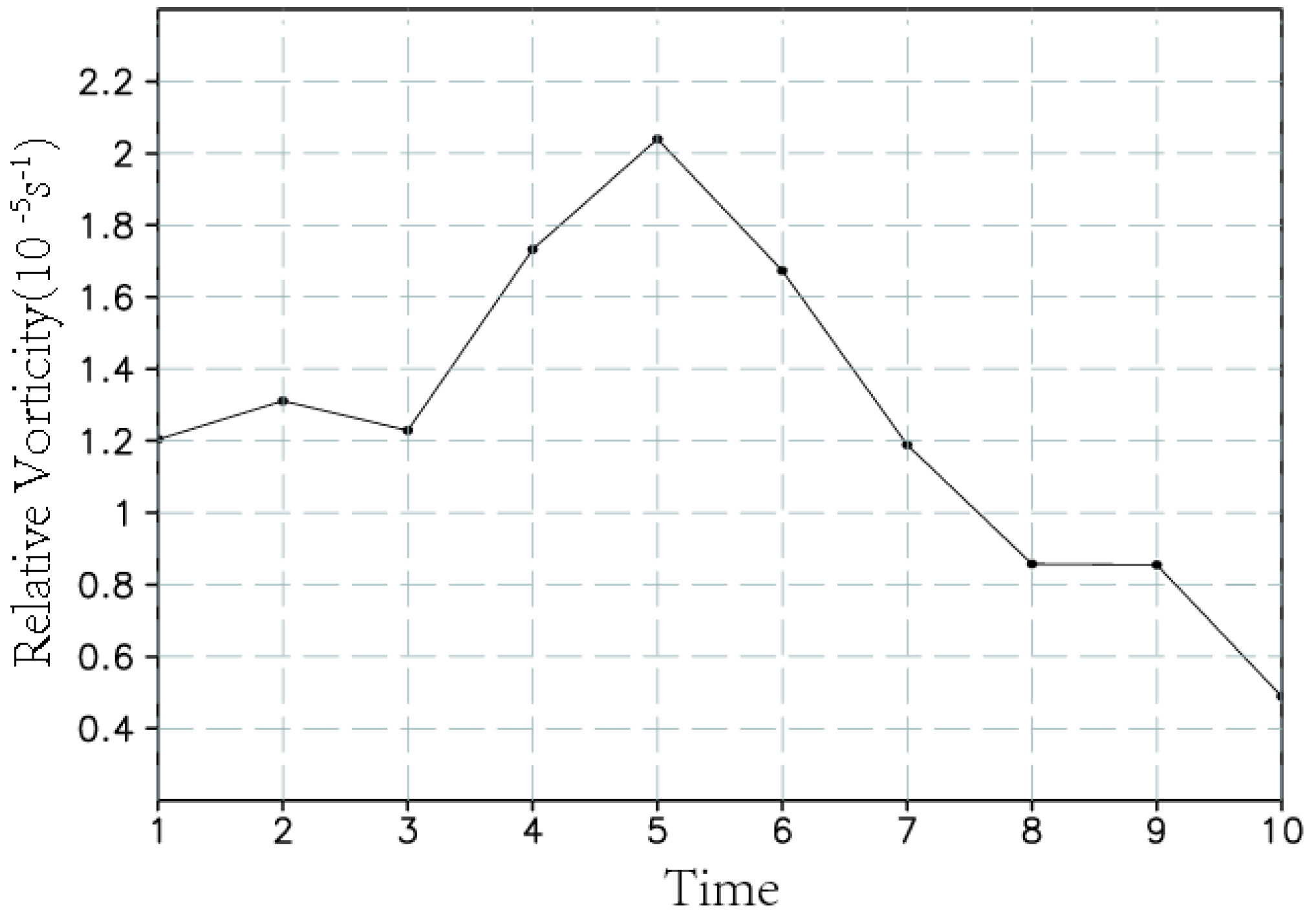
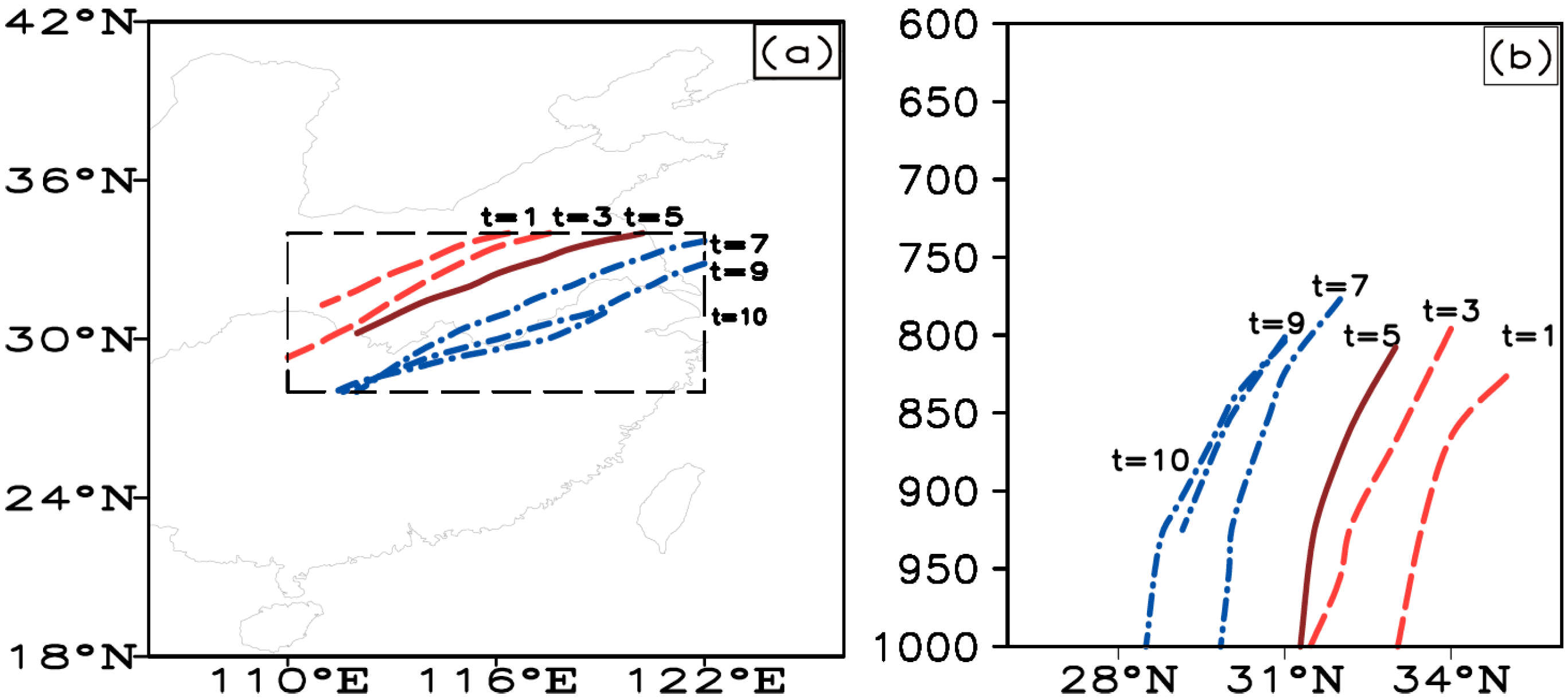
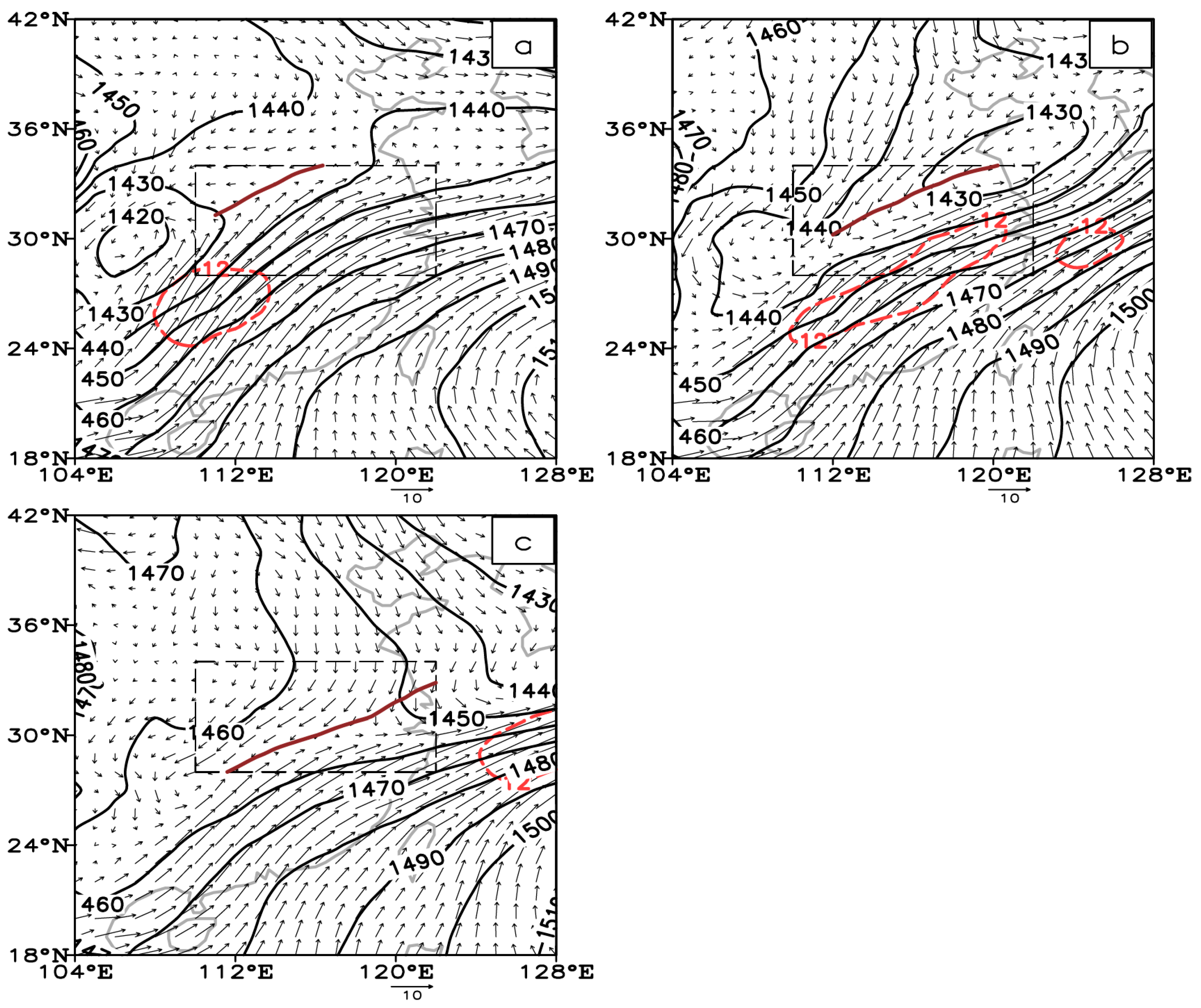
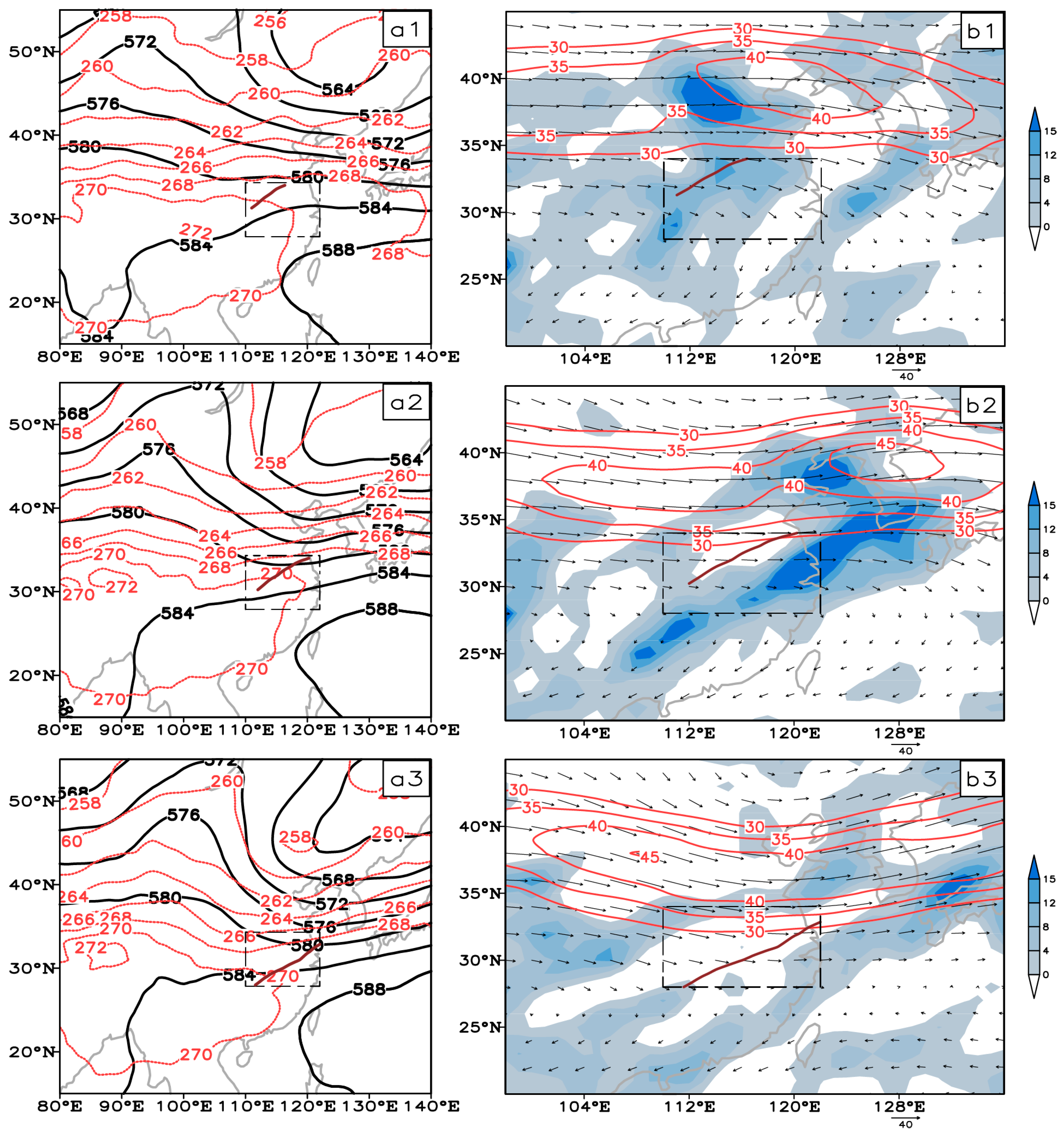
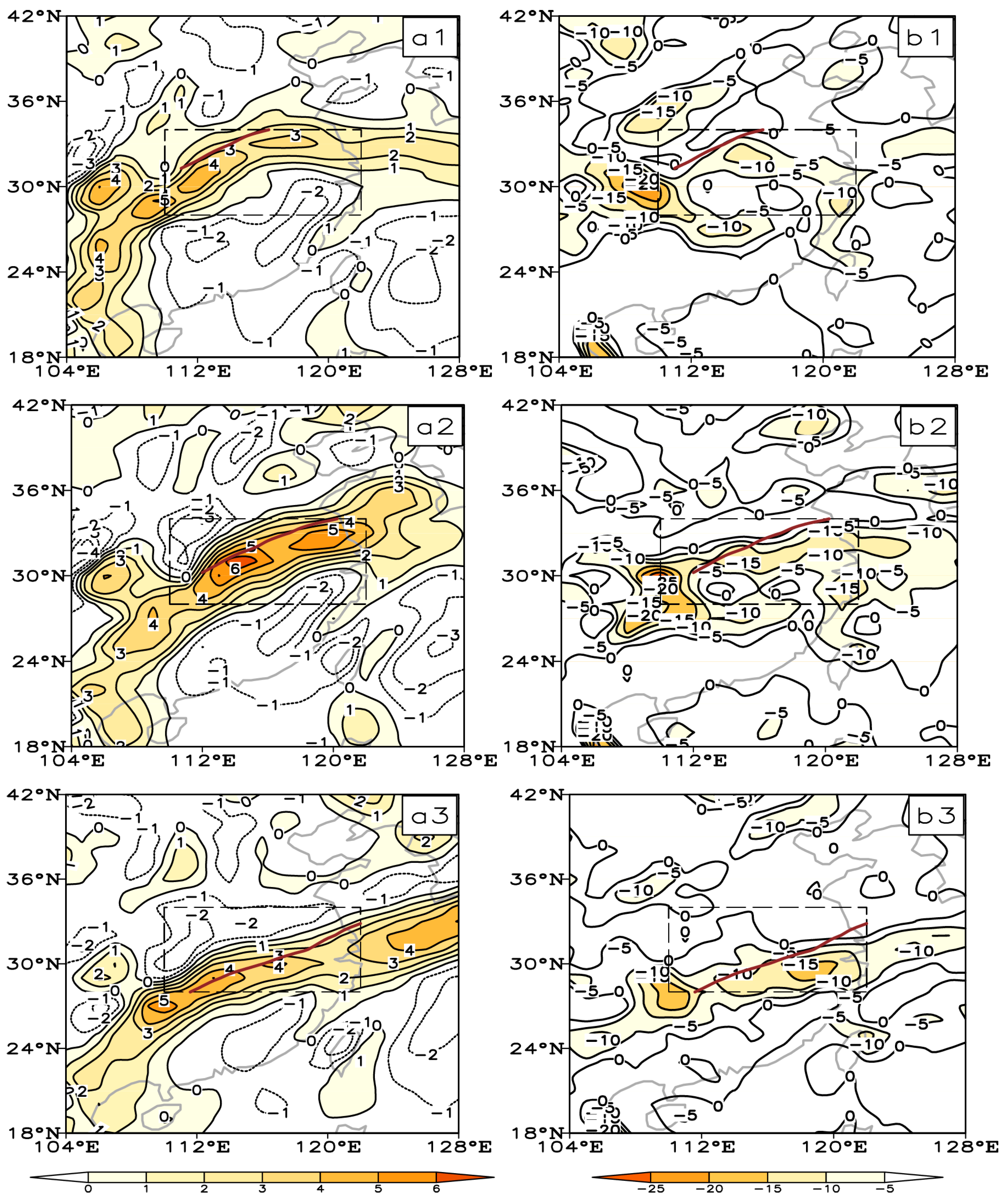
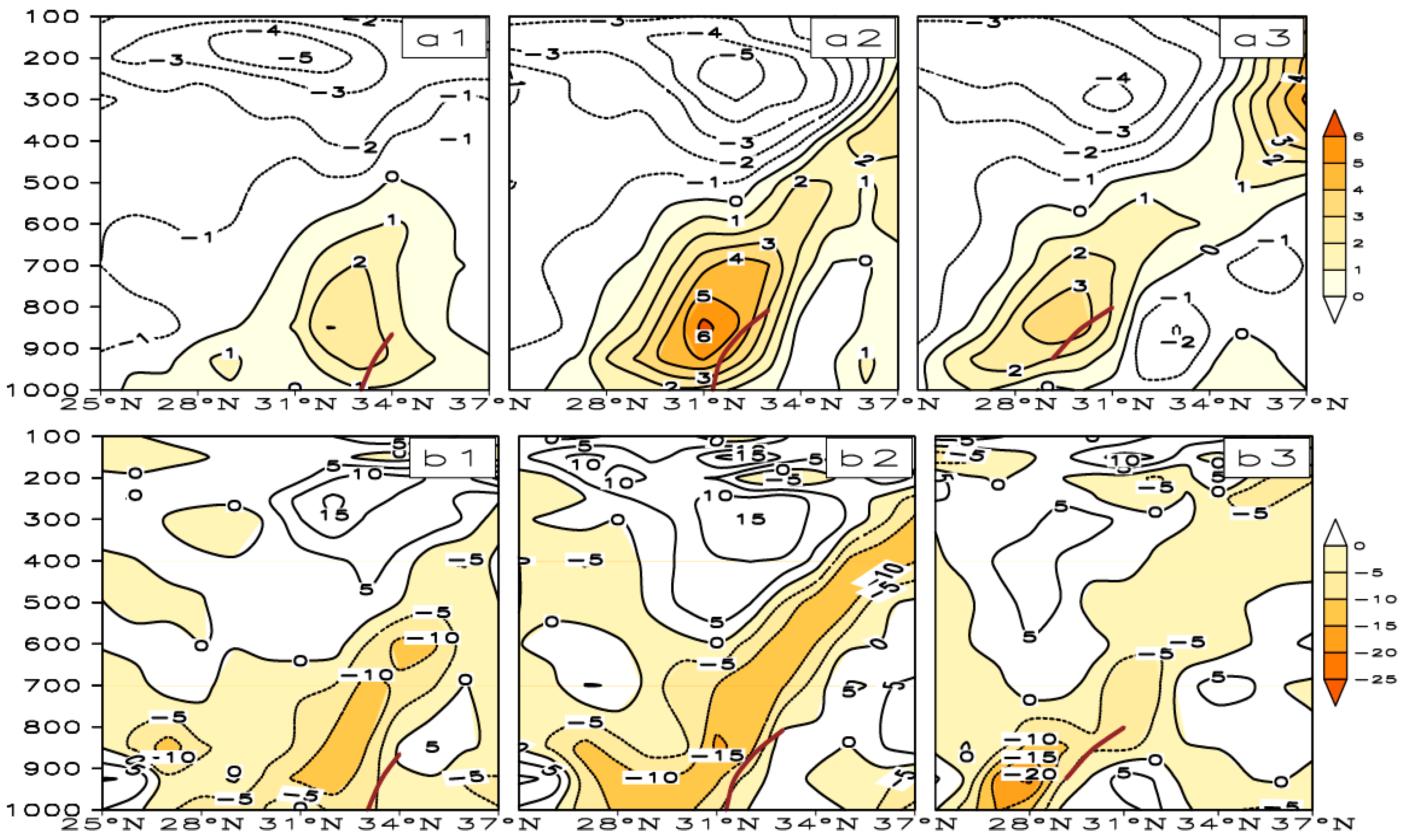



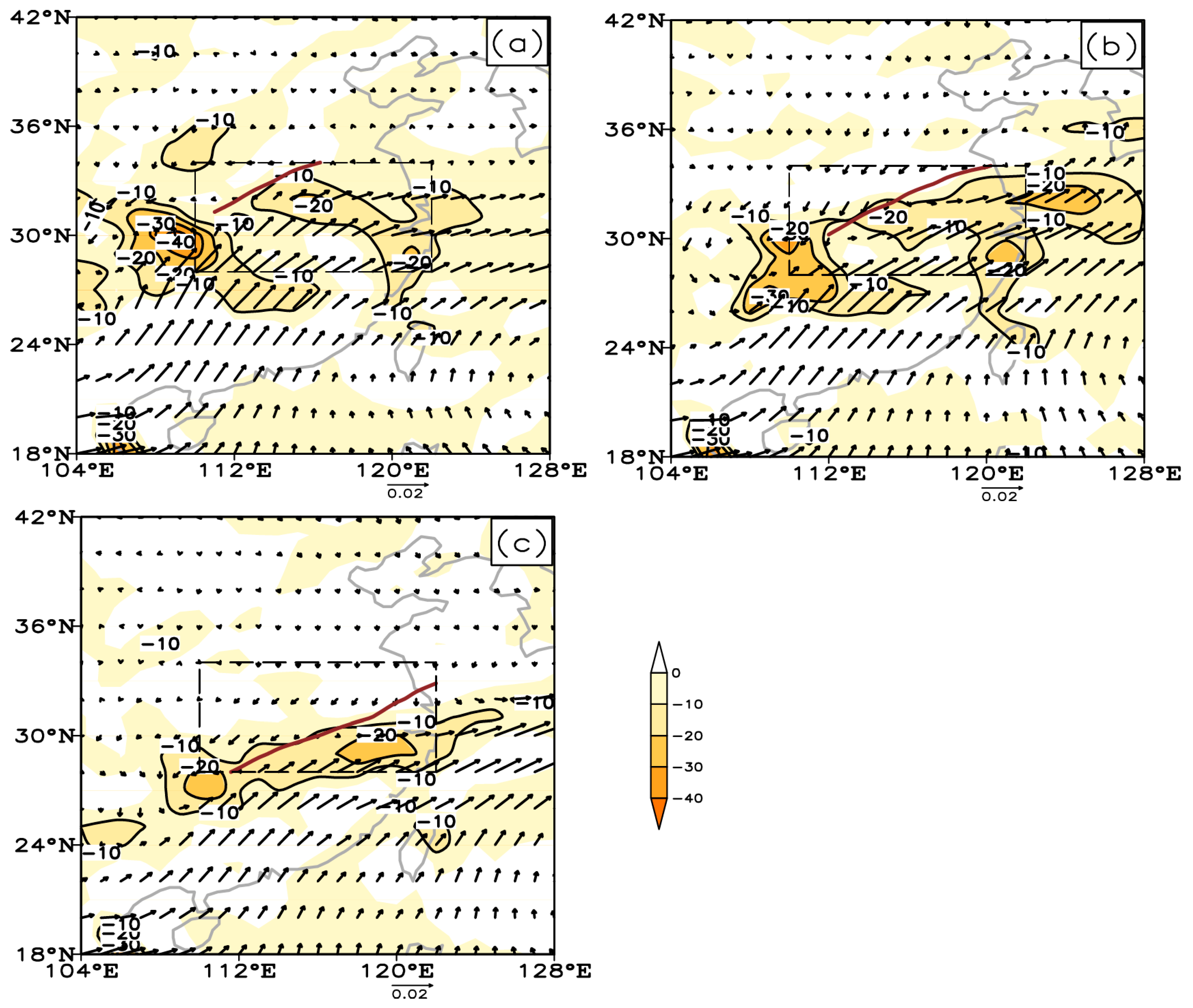

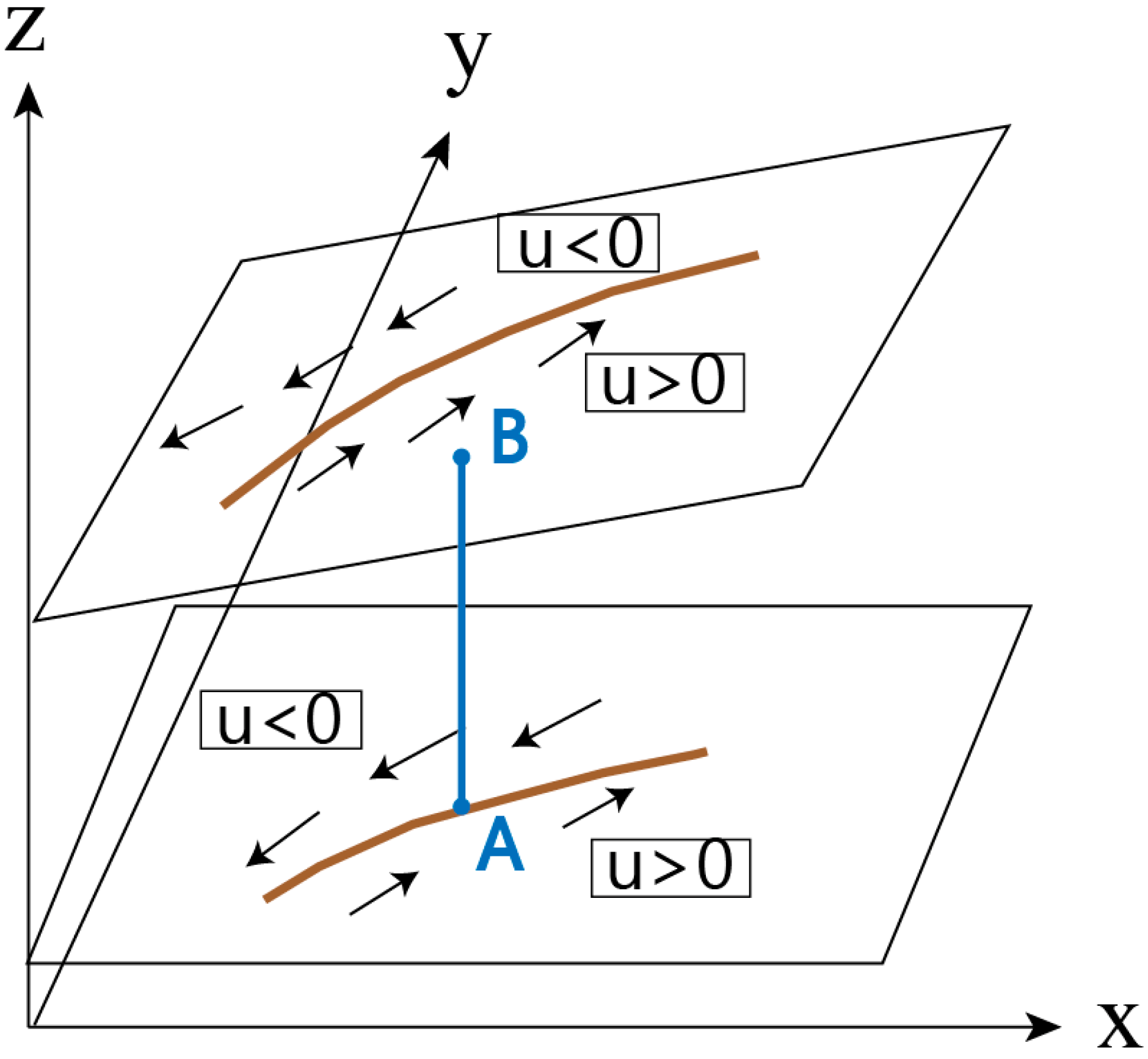
| Date | 1991. 6.16 | 1999. 6.16 | 2002. 7.24 | 2003. 6.27 | 2009. 6.30 | 2011. 6.10 | 2014. 6.20 | 2014. 7.12 | 2015. 6.17 | 2016. 6.24 |
|---|---|---|---|---|---|---|---|---|---|---|
| Number of rainstorm stations | 32 | 82 | 47 | 32 | 118 | 57 | 31 | 49 | 84 | 32 |
© 2019 by the authors. Licensee MDPI, Basel, Switzerland. This article is an open access article distributed under the terms and conditions of the Creative Commons Attribution (CC BY) license (http://creativecommons.org/licenses/by/4.0/).
Share and Cite
Yan, L.; Yao, X. Structural Characteristics of the Yangtze-Huaihe Cold Shear Line over Eastern China in Summer. Atmosphere 2019, 10, 207. https://doi.org/10.3390/atmos10040207
Yan L, Yao X. Structural Characteristics of the Yangtze-Huaihe Cold Shear Line over Eastern China in Summer. Atmosphere. 2019; 10(4):207. https://doi.org/10.3390/atmos10040207
Chicago/Turabian StyleYan, Lizhu, and Xiuping Yao. 2019. "Structural Characteristics of the Yangtze-Huaihe Cold Shear Line over Eastern China in Summer" Atmosphere 10, no. 4: 207. https://doi.org/10.3390/atmos10040207
APA StyleYan, L., & Yao, X. (2019). Structural Characteristics of the Yangtze-Huaihe Cold Shear Line over Eastern China in Summer. Atmosphere, 10(4), 207. https://doi.org/10.3390/atmos10040207




